I want to believe, but ... Virtual reality or unreal virtuality of sound Ossic X
We offer to discuss another controversial project, which brought together quite a bit of money on the kickstarter. As in the previous publication of ambiguous innovations in the field of audio systems, we will talk about headphones . Fundraising developers "3D-miracle" from Ossic X began in the year before last, and this month they plan to start small-scale production. Scant information about the project and the lack of data on the characteristics of the next "super ears" do not inspire confidence in skeptics. Meanwhile, for the project, the developers collected $ 2,700,000 (with an estimated starting cost of the product on the market $ 500, for providing support $ 200).
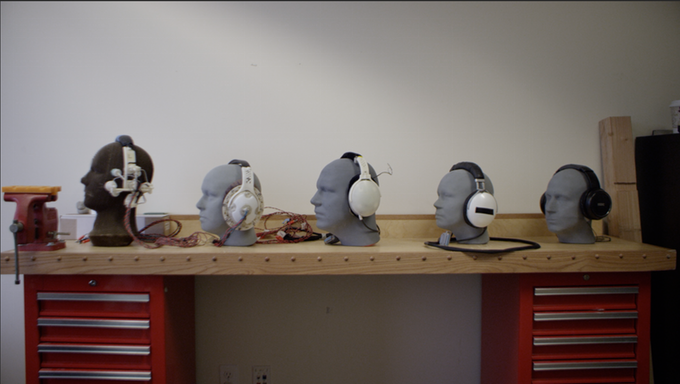
In this material, we will try to understand what the people supporting the project have done, and what ambiguous moments suggest serious thoughts about the possible fakeness of the developers' assurances. I admit that lightning-fast fundraising for the project and positive feedback on the prototypes, I am personally impressed. Unfortunately, while the device is available only on pre-order, we cannot test it and make an unequivocal conclusion. But, probably, we will make another publication, when this miracle of modern technology will be at our disposal. Read more - under the cut.
Like the Nura project, which we considered in a previous publication, the Ossic X developers position their headphones as the technical embodiment of a revolutionary idea based on the characteristics of hearing. Unlike those mentioned by Nura, it is not physiology (for example, otoacoustic emission), but human anatomy that is taken as a basis. According to the developers, Ossic X is able to constantly (real time) adapt to the anatomical features of the listener.
')

The idea of continuous calibration, from a technical point of view, does not cause prejudice and is easily tested in practice. At the same time, it remains unclear exactly how the calibration is performed and what parameters it affects. Psychoacoustic studies, when developing the first stereo and quad systems, reached a level at which sound can be reproduced with a fairly realistic arrangement of apparent sound sources, which can hardly be considered an innovation in the full sense of the word. Many modern headphones are free from the "sound inside the head" problem, without the use of automatically calibrating modules.
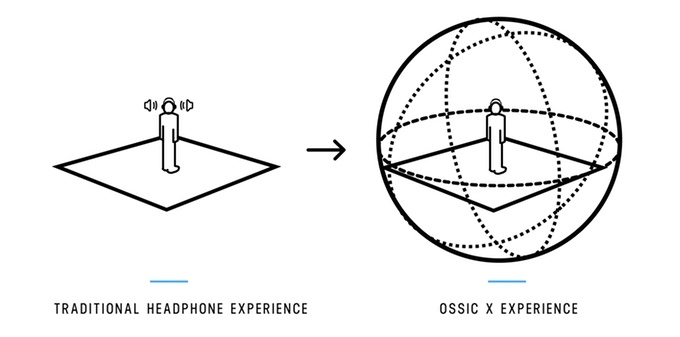
One more thing, very vague calibration statements appear in the developer’s materials:
Based on what has been written, it is possible to judge that the developers are cunning about the calibration. If changes in the position of the head really require constant adjustment (for example, when playing games), then to take into account the anatomical features of the ear, constant calibration is hardly needed. It also remains unclear what technology is used by the device to obtain information about the shape of the ear and other anatomical features associated with the perception of sound waves.
According to the Ossic X team, the headphones are equipped with an integrated head and torso (?) Position tracking system, as well as a processor using an anatomical calibration algorithm. It should be noted that the developers use HRTF (Head related transfer function) as a scientific basis, a transfer function depending on the listener's position in space, the location of sound sources and the distance between ears (according to the developers, also on ears, but I could not find confirmation of this thesis).

Source: audiophilesoft.ru/publ/theory/hrtf/6-1-0-342

It is important to understand that HRTF is the basis for panning in all existing systems for recording and reproducing surround sound, including classical stereo. This characteristic is not something fundamentally new either in biophysics or psychoacoustics, and is almost always taken into account when developing audio equipment. The creators of the headphones do not give a mathematical justification, they only mention in a passing way that the algorithm is built by HRTF. Why the torso is mentioned remains unclear, as well as the principle of operation of sensors that track the position of body parts.
The following statement raises even more serious doubts:
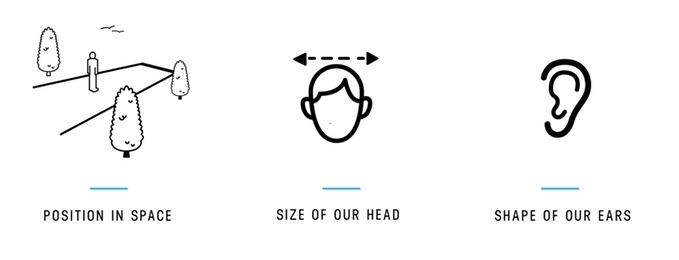
It is known that the perception of sound waves is unique and depends on the anatomy of the organ of hearing. It remains unclear exactly how the system determines the shape of the auricle, and on the basis of what criteria the calibration is made, taking into account this parameter.
The original design of the Ossic X used 8 speakers, which are designed to provide a realistic sound picture.

Probably, the developers were impressed by the experience of creating 7.1 systems that allow you to play a truly surround sound. It should be noted that in order to create a realistic sound picture similar to the system, it is necessary to reproduce a seven-channel sound. I would venture to assume (possibly mistaken) that the traditional 7.1 concept is difficult to use for headphones , since it loses its meaning due to the small distance between the emitters and the ear.
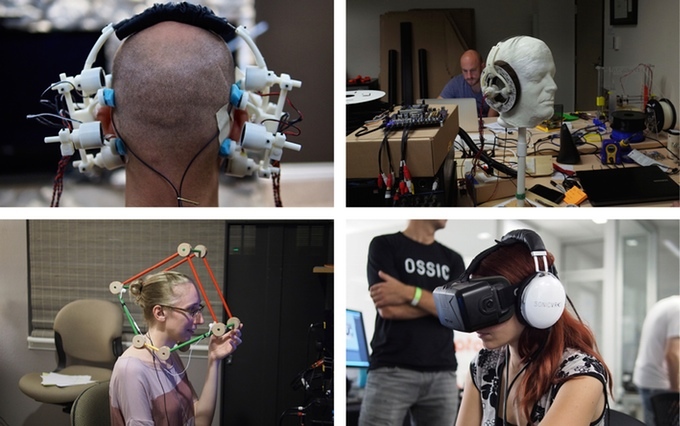
How else the number of speakers changes the sound in the headphones is not specified. I would venture to suggest that in this way a dense sound is achieved. This in itself is good, but it has only indirect relation to the volume and the formation of the scene. It remains unknown whether the crossover is implemented in the headphones or whether the broadband speakers are used.
Ossic X has the following integration and connectivity options: USB, AUX, 3.5 mm jack. Provided support for stereo playback, 5.1 and 7.1. VST and AU support is planned for sounds created using the DAWs standard.
The Ossic X team is actively attracting the creators of gaming platforms to develop special plug-ins for Unity, Unreal, Wwise, VST, AU, etc. At the moment, a prototype of the FMOD plugin has been developed.
The developers claim that they conducted research, the data of which formed the basis of the product. With the help of a microphone placed in the ear, they established whether the headphone reproduces the same signal as the real sound in space. The results of the Ossic X comparative test and standard gaming headphones are presented in the graph below.
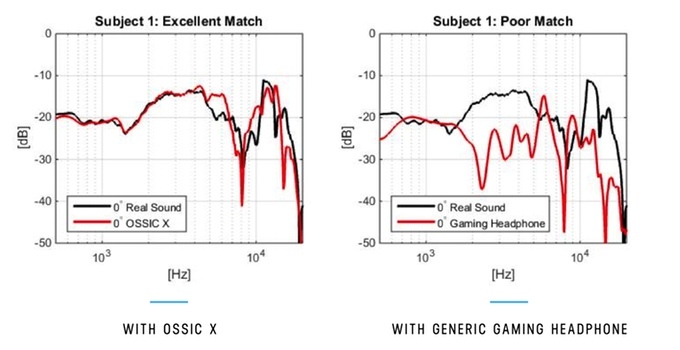
In addition, with the participation of the focus group, the developers tried to determine where, in the opinion of the subjects, the sound comes from during playback. According to the developers, their product, unlike other headphones, allows you to correctly determine the direction of location and distance of the sound.


For convinced skeptics of information is extremely small. Moreover, the project’s reputation was spoiled by the article “Viel Lärm um nichts: 3D-Kopfhörer Ossic X ausprobiert” (“Much Ado About Nothing: I Tried Ossic X), published by the German resource heise.de, 06/01/2017, after the CES exhibition. In the article, the author wrote that it is better not to turn on the 3D sound in the headphones, and with the traditional unprocessed playback, these are quite suitable high-quality headphones that are worth their money, but are not something revolutionary.
Meanwhile, the little gullible audiophile inside me sincerely wants to believe that people did not spend $ 2,700,000 in vain, and the product has at least some of the stated characteristics. Hope you leave your opinion in the comments.

In this material, we will try to understand what the people supporting the project have done, and what ambiguous moments suggest serious thoughts about the possible fakeness of the developers' assurances. I admit that lightning-fast fundraising for the project and positive feedback on the prototypes, I am personally impressed. Unfortunately, while the device is available only on pre-order, we cannot test it and make an unequivocal conclusion. But, probably, we will make another publication, when this miracle of modern technology will be at our disposal. Read more - under the cut.
Anatomy and sound
Like the Nura project, which we considered in a previous publication, the Ossic X developers position their headphones as the technical embodiment of a revolutionary idea based on the characteristics of hearing. Unlike those mentioned by Nura, it is not physiology (for example, otoacoustic emission), but human anatomy that is taken as a basis. According to the developers, Ossic X is able to constantly (real time) adapt to the anatomical features of the listener.
')
“These are the first headphones in the world that constantly adjust to your anatomy for the most accurate and exciting 3D audio.”

The idea of continuous calibration, from a technical point of view, does not cause prejudice and is easily tested in practice. At the same time, it remains unclear exactly how the calibration is performed and what parameters it affects. Psychoacoustic studies, when developing the first stereo and quad systems, reached a level at which sound can be reproduced with a fairly realistic arrangement of apparent sound sources, which can hardly be considered an innovation in the full sense of the word. Many modern headphones are free from the "sound inside the head" problem, without the use of automatically calibrating modules.

One more thing, very vague calibration statements appear in the developer’s materials:
"Audio algorithms with head tracking and individual anatomical adjustment"
Based on what has been written, it is possible to judge that the developers are cunning about the calibration. If changes in the position of the head really require constant adjustment (for example, when playing games), then to take into account the anatomical features of the ear, constant calibration is hardly needed. It also remains unclear what technology is used by the device to obtain information about the shape of the ear and other anatomical features associated with the perception of sound waves.
Ossic X watching over the head
According to the Ossic X team, the headphones are equipped with an integrated head and torso (?) Position tracking system, as well as a processor using an anatomical calibration algorithm. It should be noted that the developers use HRTF (Head related transfer function) as a scientific basis, a transfer function depending on the listener's position in space, the location of sound sources and the distance between ears (according to the developers, also on ears, but I could not find confirmation of this thesis).

"The transfer function H (f) of any linear time invariant system at frequency f has the form:
H (f) = Output (f) / Input (f)
The method of determining HRTF also allows to obtain the impulse response (HRIR) h (t) for the eardrum, which is the response to the impulse Δ (t) reproduced by the source. HRTF H (f) is the Fourier transform of the impulse response h (t). ”
Source: audiophilesoft.ru/publ/theory/hrtf/6-1-0-342

It is important to understand that HRTF is the basis for panning in all existing systems for recording and reproducing surround sound, including classical stereo. This characteristic is not something fundamentally new either in biophysics or psychoacoustics, and is almost always taken into account when developing audio equipment. The creators of the headphones do not give a mathematical justification, they only mention in a passing way that the algorithm is built by HRTF. Why the torso is mentioned remains unclear, as well as the principle of operation of sensors that track the position of body parts.
What determines the shape of the ear?
The following statement raises even more serious doubts:
“It allows your unique ear shape to interact with 3D sound in the same way it does with real-life sounds.”

It is known that the perception of sound waves is unique and depends on the anatomy of the organ of hearing. It remains unclear exactly how the system determines the shape of the auricle, and on the basis of what criteria the calibration is made, taking into account this parameter.
Design - 8 speakers and only 2 ears
The original design of the Ossic X used 8 speakers, which are designed to provide a realistic sound picture.
"A set of speakers provides the exact location of sound in space."

Probably, the developers were impressed by the experience of creating 7.1 systems that allow you to play a truly surround sound. It should be noted that in order to create a realistic sound picture similar to the system, it is necessary to reproduce a seven-channel sound. I would venture to assume (possibly mistaken) that the traditional 7.1 concept is difficult to use for headphones , since it loses its meaning due to the small distance between the emitters and the ear.

How else the number of speakers changes the sound in the headphones is not specified. I would venture to suggest that in this way a dense sound is achieved. This in itself is good, but it has only indirect relation to the volume and the formation of the scene. It remains unknown whether the crossover is implemented in the headphones or whether the broadband speakers are used.
Connection and integration
Ossic X has the following integration and connectivity options: USB, AUX, 3.5 mm jack. Provided support for stereo playback, 5.1 and 7.1. VST and AU support is planned for sounds created using the DAWs standard.
The Ossic X team is actively attracting the creators of gaming platforms to develop special plug-ins for Unity, Unreal, Wwise, VST, AU, etc. At the moment, a prototype of the FMOD plugin has been developed.
Research
The developers claim that they conducted research, the data of which formed the basis of the product. With the help of a microphone placed in the ear, they established whether the headphone reproduces the same signal as the real sound in space. The results of the Ossic X comparative test and standard gaming headphones are presented in the graph below.

In addition, with the participation of the focus group, the developers tried to determine where, in the opinion of the subjects, the sound comes from during playback. According to the developers, their product, unlike other headphones, allows you to correctly determine the direction of location and distance of the sound.


I want to believe ...
For convinced skeptics of information is extremely small. Moreover, the project’s reputation was spoiled by the article “Viel Lärm um nichts: 3D-Kopfhörer Ossic X ausprobiert” (“Much Ado About Nothing: I Tried Ossic X), published by the German resource heise.de, 06/01/2017, after the CES exhibition. In the article, the author wrote that it is better not to turn on the 3D sound in the headphones, and with the traditional unprocessed playback, these are quite suitable high-quality headphones that are worth their money, but are not something revolutionary.
Meanwhile, the little gullible audiophile inside me sincerely wants to believe that people did not spend $ 2,700,000 in vain, and the product has at least some of the stated characteristics. Hope you leave your opinion in the comments.
Source: https://habr.com/ru/post/400945/
All Articles